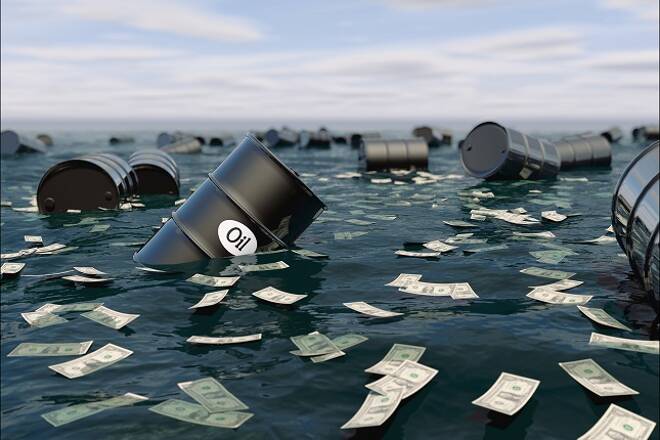Advertisement
Advertisement
Oil Price Fundamental Weekly Forecast – Traders Centered on COVID-19 as Rising Global Cases Keep Lid on Prices
By:
The wild cards are the coronavirus vaccine and the OPEC+ production cuts. A vaccine will reduce the number of cases and ease restrictions.
U.S. West Texas Intermediate and international-benchmark Brent crude oil futures finished lower last week while posting inside moves. The chart pattern indicates investor indecision and impending volatility. The fundamentals also supported the inside trade. There wasn’t any blockbuster news following the previous week’s massive short-covering rally, but just enough bearish news to cap gains and bullish news to underpin prices.
The price action also indicates we could be in for a rangebound trade just like the one we saw in July and August albeit at lower prices. The rangebound trade reflects similar fundamentals. The lower prices, however, indicate expectations of lower demand due to a resurgence in global coronavirus cases.
Last week, December WTI crude oil settled at $40.51, down $1.10 or -2.64% and December Brent crude oil finished at $42.41, down $1.27 or -2.99%.
Demand Concerns Weigh on Prices
Rising coronavirus cases helped put a lid on prices last week. In Europe and Asia, daily increases of coronavirus infections are hitting records and new restrictions are being put in place that will likely limit travel and fuel demand.
The situation is also worsening in India where throughput by crude oil refiners in August fell 26.4% from a year ago, the most in four months, as fuel demand ebbed because surging coronavirus cases hindered industrial and transport activity.
And the problems are not isolated in Europe and Asia either. In the United States, unemployment claims unexpectedly rose last week suggesting an economic recovery is sputtering and pushing down fuel demand.
Infections are also rising in the U.S., the world’s top oil consumer. We’re seeing a resurgence of COVID-19 cases in the Midwest, while New York City, which was hit hardest in the spring, is considering renewed shutdown mandates.
Travel constraints are likely to be the biggest concern for traders over the near-term. Since the travel industry – especially airlines – never really recovered from the first wave of the virus.
Government data showed last week that the four-week average of gasoline demand was 9% below a year earlier. Demand is likely to weaken over the near-term because the increasing coronavirus numbers are slowing the economic recovery.
Don’t Forget About Supply
By all means and measures, last week’s government inventories report was bullish, but that didn’t drive prices higher for the week. This is further evidence that demand is the major concern.
U.S. crude, gasoline and distillate inventories all fell the week-ending September 18, EIA data showed. Crude inventories fell by 1.6 million barrels, less than forecast; gasoline stocks dropped more than expected, sliding by 4 million barrels; while distillate stockpiles posted a surprise drawdown of 3.4 million barrels.
Although OPEC+ is doing its best to curtail global supply with its massive production cuts, and could do more if called upon, there could be a problem if Libya brings more oil to the market.
In Libya, an oil tanker was loading cargo on Thursday from one of three Libyan terminals that were reopened in recent days and more cargoes are expected to be lifted in the coming days. It may look bearish on the surface, but analysts are questioning how quickly the country could ramp up supply.
There are additional reports that Iranian oil exports have risen sharply in September in defiance of U.S. sanctions, three assessments based on tanker tracking showed, throwing a lifeline to the Islamic Republic and its collapsing economy.
Weekly Forecast
We’re expecting a sideways-to-lower trade over the near-term as long as the number of COVID-19 cases continue to rise worldwide. On the downside, the biggest concern will be renewed restrictions in the U.S., Europe and Asia.
Other factors that could weigh on prices is a stronger U.S. Dollar that tends to reduce foreign demand for dollar-denominated crude oil. This goes hand in hand with the strength of the U.S. economy. Increased supply from Libya and Iran could also become bearish factors.
The drop in distillates is encouraging because it could be an early indication of renewed demand. However, if the airlines don’t get stimulus money then distillate prices could plunge again.
The wild cards are the coronavirus vaccine and the OPEC+ production cuts. A vaccine will reduce the number of cases and ease restrictions. OPEC+’s output cuts are helping to underpin prices, but they may need to do more. Over a week ago, prices rose sharply when they said they were cracking down on over producers. Another steep decline could lead them to tighten the screws even further.
For a look at all of today’s economic events, check out our economic calendar.
About the Author
James Hyerczykauthor
James Hyerczyk is a U.S. based seasoned technical analyst and educator with over 40 years of experience in market analysis and trading, specializing in chart patterns and price movement. He is the author of two books on technical analysis and has a background in both futures and stock markets.
Advertisement
